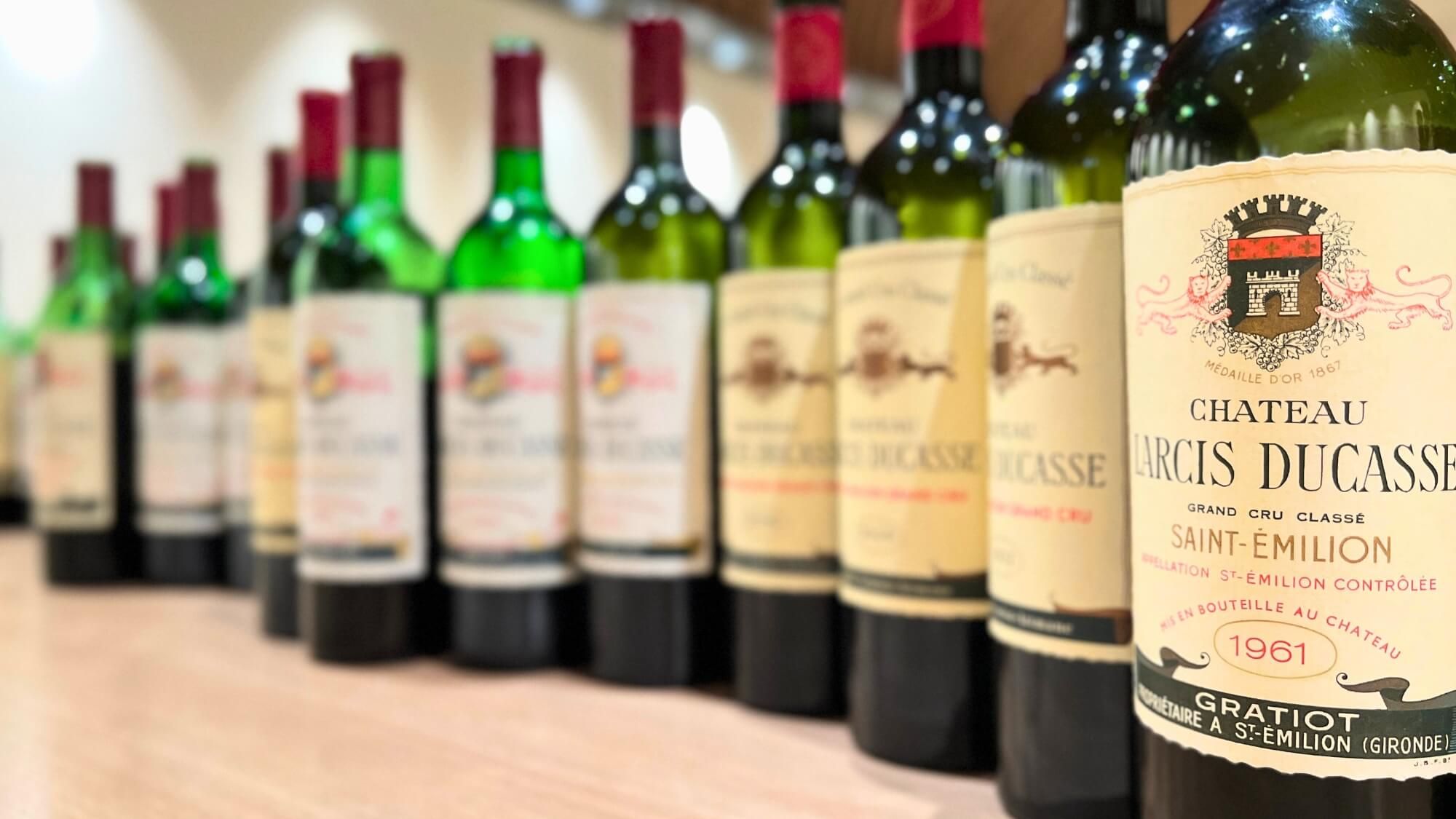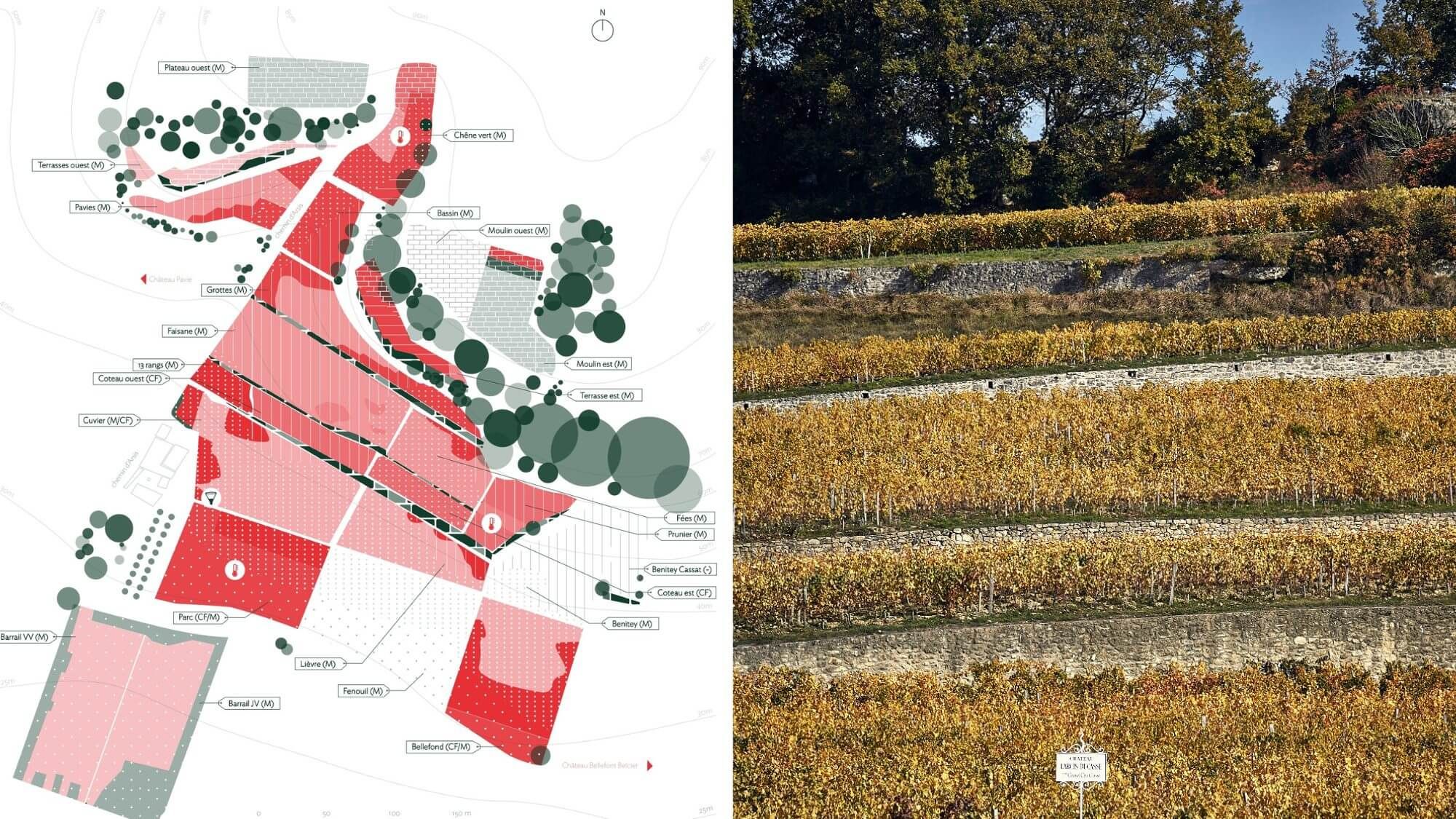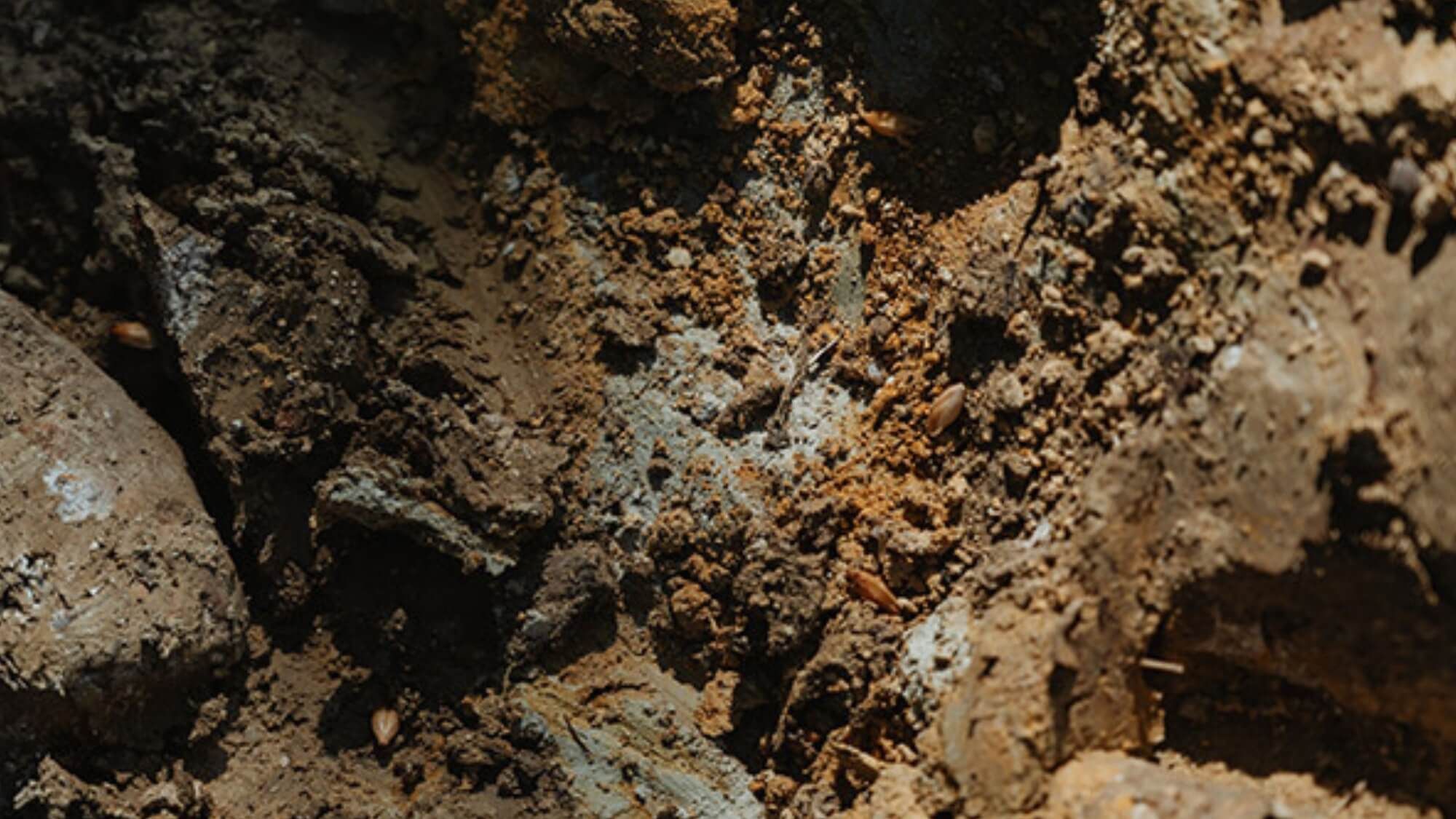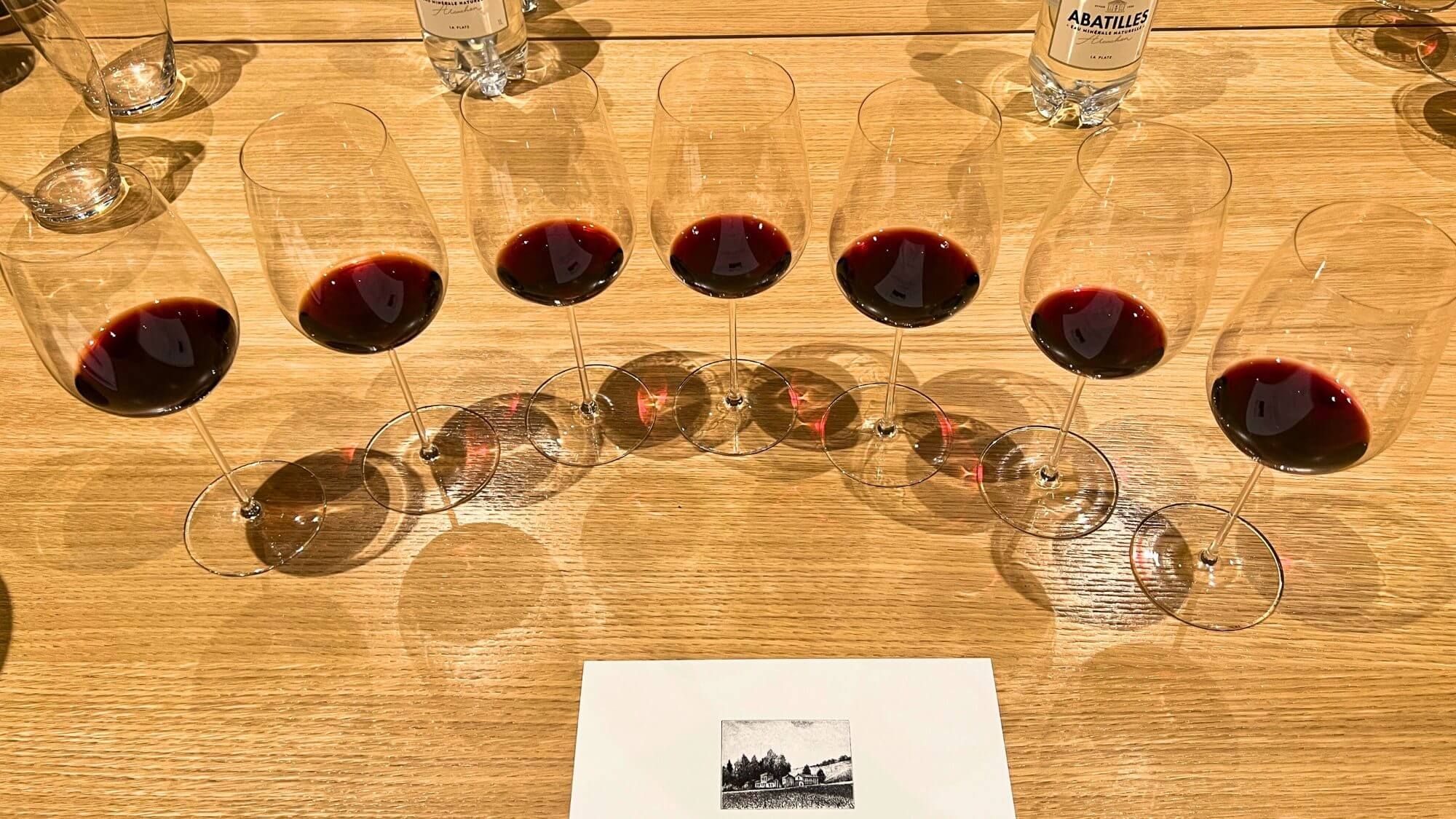AMA Vertical Tasting
Château Larcis Ducasse
(1959-2022)

AMA Snapshot of Château Larcis Ducasse
- Rich yet never heavy, balancing tradition with modern aesthetics: The wines carry the depth and gravitas of Saint-Émilion’s tradition, while also revealing a fragrance and elegance attuned to contemporary taste.
- The magic of aging: truffle after 10–15 years: Regardless of whether the vintage is warm or cool, good or difficult, after about 10–15 years of cellaring, the wines develop enchanting truffle aromas. Vintages such as 2009, 2008, 2005, and 2004 are perfect examples.
- Hot, dry years reveal its full potential: Generous, opulent, and radiant, the 2022, 2019, 2018, and 2009 vintages stand out as benchmarks.
- When heat meets strong diurnal shifts, the wines shine even brighter: They combine ripeness with refreshing notes of blood grapefruit and orange peel. Among them, 2016 and 2010 are especially reommended.
- The dominance of La Grand Côte’s slopes: Among Saint-Émilion’s Premier Grand Cru Classé estates, Larcis Ducasse holds the largest proportion of vines on La Grand Côte. With a 60-meter vertical drop across its vineyard, the site imparts a distinctive sense of depth, layering, and tension to the wines.
- A family’s guardianship: Since 1893, the estate has been managed by the same family. For more than a century, the vineyard has remained virtually unchanged.

In the star-studded landscape of Saint-Émilion, there lies a Premier Grand Cru Classé estate often spoken of by connoisseurs yet little known to the wider public: Château Larcis Ducasse. With an annual production of just over 30,000 bottles and limited visibility on the market, it has long carried a reputation summed up by the French expression “Longtemps resté un secret de connaisseurs”—for a long time, a secret kept by insiders.
During the “AMA Selection” China Tour 2025 this summer, I featured the 2022 vintage of Château Larcis Ducasse twice, in masterclasses held in Shenzhen and Shanghai. Many participants were seasoned Bordeaux enthusiasts, and their impressions were telling: one described the wine as “rich yet never cloying,” another evoked it as “a Suzhou garden under the sun,” while a third called it “a refreshing current in today’s wine world.” In just a few words, they vividly captured the distinctive aura it holds in the eyes of top Chinese consumers.
After the sessions, several friends admitted that they had hardly ever encountered this estate before. Beyond knowing it held the rank of 1er Grands Crus Classés B in Saint-Émilion, they had little else to go on.

All the more reason, then, for me to take this opportunity to share the insights and impressions I have gathered over the years through vertical tastings and in-depth study. It is time to present, in full, this hidden treasure of an estate—long cherished as a connoisseur’s secret.
Tasting Impressions
Let me begin with my impressions of Château Larcis Ducasse.
First, it shows remarkable concentration, with fruit that is full and abundant. In hot vintages, the intensity of ripe fruit can rival that of Napa, yet at the close of the tasting there is always a thread of graceful acidity that gathers the palate and leaves a lasting impression.
Second, it gains extraordinary charm with age. After 10 to 15 years of cellaring, clear notes of truffle emerge unfailingly. Even in cooler vintages, truffle seems to appear as if by decree. The 2004 and 1983 vintages are classic examples.
Third, it never shies away from so-called “weaker years.” Thanks to the south-facing exposition of its vineyards, ripeness often exceeds expectations. In vintages such as 2021, 2017, and 2012 – vintages not marked by high temperatures – these wines still surprise me with a level of richness and generosity rarely found in those conditions.

Fourth, and perhaps most magical of all, is the duality it displays in hot vintages:
- When marked by heat alone, the wine becomes sumptuous and opulent, with truffle and dark fruit aromas that are rich, heady, and lavish in their expression.
- But in years of both heat and strong diurnal variation, an entirely different face appears. Take 2010 and 2016, for example: the palate tightens swiftly after entry, with sweet berries giving way to refreshing notes of orange peel, lemon tea, and salted plum. It is in this interplay of intensity and freshness that Larcis Ducasse finds a unique balance, one of striking distinctiveness.

A Landscape of Terroir
The vineyard of Château Larcis Ducasse covers a total of 11.3 hectares, of which around 2 hectares are occupied by woodland and buildings, leaving just 9.5 hectares under vine. The estate stretches seamlessly down the Saint-Émilion plateau from north to south, without interruption. From the crest to the foot of the slope, there is a 60-meter drop in altitude, which means that ripening within the same vineyard can vary by as much as three weeks.
South-facing exposure is the signature of this estate. It shields the vines from the northern winds and ensures ample sunlight throughout the growing season. Combined with naturally favorable drainage, this gives the fruit greater ripeness and a more generous, sweetly aromatic profile.
What is even more remarkable is the hidden “water network” that lies beneath the soils, running from the top to the base of the slope. This gift of nature allows Château Larcis Ducasse to retain elegance and balance even in hot, dry vintages.

And now, we arrive at my favorite part—the chapter of soils. It is without doubt the most technical and challenging section of this article, but it is also the very key that separates the casual enthusiast from the true connoisseur. Follow along with me, and you will see that it is, in fact, much simpler than it seems.
The Three Themes of the Vineyard
Broadly speaking, the vineyards of Château Larcis Ducasse can be divided into three distinct sections: the upper plateau (Le Plateau), the great mid-slope (La Grande Côte), and the lower foot of the slope (Le Pied de Côte).
1. The Upper Plateau (Le Plateau)
Almost entirely composed of classic starfish limestone (Astéries Limestone), this section makes up 15% of the estate’s surface, with more than half of its production going into the Grand Vin.
This terroir gives the wine bright acidity, crystalline clarity, and a distinctive saline note, lending Château Larcis Ducasse a tall, elegant profile with a graceful sense of extension.

On the western side of the plateau lies a small patch of blue clay, reminiscent of Pomerol. Grapes from this soil contribute firm tannins and structure, and once finely polished, they bring a noble, refined framework to the wine.

2. The Mid-Slope (La Grande Côte)
This is the estate’s core vineyard, accounting for 50% of plantings, with about 70% of its fruit used in the Grand Vin. With a slope of up to 25°, nearly all vineyard work here must be carried out by hand. Its growth rhythm is unique: the vines are the earliest to bud but the very last to ripen, with a cycle longer than almost any other site.
“On the Grande Côte, spring water seeps through the limestone and resurfaces in the clay. The landscape is like a chessboard, alternating between dry and moist parcels: the southern exposures bask in sunshine, giving warmth and radiant aromatics, while the sandy marls provide lasting freshness. The contrast between the two is ever-present.”
David’s description captures the essence of this terroir, but if we look closer, the Grande Côte can itself be divided into two parts:
- Upper slope: Dominated by white clay rich in limestone, producing wines of crystalline purity, lively on the palate, shimmering like flickers of light.
- Lower slope (commonly known as Côte Pavie): A deep fusion of clay and limestone, yielding greater structure and fuller body, with a style that is generous, expressive, and full of tension.

3. The Foot of the Slope
This section represents 15% of the vineyard, though less than 20% of its fruit finds its way into the Grand Vin. The terrain here is almost flat, with just a 2–5% incline, and the soils are composed of sandy marl and alluvial deposits. Grapes from this site do not contribute imposing structure, but they are notable for their aromatic expression, often marked by dark, juicy berries with relatively gentle tannins.

A Timeline of Technical Evolution
Since 1893, Château Larcis Ducasse has remained under the stewardship of the same family. To trace its path of progress, I have woven together its history and its technical evolution along a timeline.
1893 – 1978
Henri Raba, from a prominent Bordeaux family, purchased Château Larcis Ducasse and poured much of his fortune into it. He not only restored the terraced vineyards but also built one of the most advanced gravity-flow cellars of the time. Historical records note:
“Henri Raba constructed a vast vat room, equipped with a press that could move along rails on the first floor, allowing the harvest carts to drive straight in.” This was a truly forward-looking innovation for that era.
However, the two World Wars pressed pause on the estate’s development. Henri Raba’s only son was killed in the conflict, and with no direct heir, his niece Hélène Gratiot-Alphandéry assumed the family’s legacy. In 1945, after the war, she managed the estate alongside technical director Pharaon Roche. Given the economic hardships of the time, there were no major upgrades to the estate’s technology or equipment during this period.

1990 – 2001
In 1990, Hélène’s son, Jacques-Olivier Gratiot, finally returned to the estate. Previously he had served as Director of Creativity and Development at L’Oréal, while also pursuing life as a poet and writer. I met him several times during harvest; he struck me as a lively, energetic “eternal child,” full of charm and warmth.
That said, to be frank, the wines produced in his first decade at the helm were not among the estate’s best. At the time, much of the fruit from the foot of the slope was included in the Grand Vin, which diluted aromatic precision and finesse. The cellar, too, was not optimally maintained, and issues with Brettanomyces occasionally appeared—for instance in the 1989 and 1990 vintages—though without seriously detracting from the overall tasting experience.

A New Era: Turning Point and Ascent
In 2002, Jacques-Olivier Gratiot entrusted winemaking entirely to Nicolas Thienpont and David Suire, with renowned consultants Stéphane Derenoncourt and his partner Julien Lavenu joining the project. From that moment, Château Larcis Ducasse entered a phase of genuine expansion. The new team brought a modern outlook and a comprehensive program of improvements and innovations, including several pivotal technical upgrades:
- Finer viticultural management: parcel-by-parcel work and precision farming.
- Vineyard optimization: higher planting density, the introduction of Cabernet Franc, a progressive move toward organic growing, and the rebuilding of a healthy soil ecosystem.
- Cellar innovation: beginning in 2008, the adoption of pigeage (punching down) to extract tannins and flavor more delicately; in 2010, the launch of the second wine, Murmur, further sharpening the quality of the Grand Vin.
- Oak regime update: from 2012 onward, a shift away from small barrels toward a mix of 500-liter and larger casks, avoiding excessive embellishment and highlighting the estate’s authentic style.
- Harvest and cellar operations: the picking window was extended from 2–3 days to 2–3 weeks to ensure each parcel is harvested at optimal maturity, with rigorous hand-sorting and meticulous vinification applied throughout.

Thanks to nearly two decades of steady refinement, Château Larcis Ducasse has carved out its own balance between tradition and modernity, elevating the estate into the ranks of truly top-tier wines. And this evolution shows no sign of stopping.
In 2024, overall management passed fully to David Suire, while sales were entrusted to a new generation professional, Alice Leuret. Having devoted over twenty years to Château Larcis Ducasse, David likely knows this land better than anyone; Alice, fluent in multiple languages, excels at building bridges across cultures and markets. With the support of today’s principals, Ariane Gratiot and Amel Attmane, they are poised to carry the name Château Larcis Ducasse to ever wider horizons.

I believe the day will come when Château Larcis Ducasse appears in many more glasses across the Chinese wine community, no longer just “a little secret among Western connoisseurs.” I know this piece is quite dense, but if you’ve made it this far, I can promise your understanding of this estate is now among the very best in the field.
That’s all for now. Until the next vertical, cheers!

